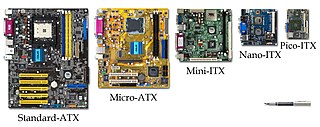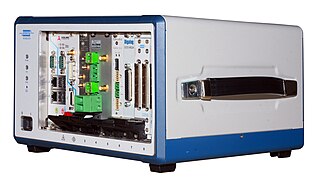Related Research Articles

In computing, an expansion card is a printed circuit board that can be inserted into an electrical connector, or expansion slot on a computer's motherboard to add functionality to a computer system. Sometimes the design of the computer's case and motherboard involves placing most of these slots onto a separate, removable card. Typically such cards are referred to as a riser card in part because they project upward from the board and allow expansion cards to be placed above and parallel to the motherboard.

VMEbus is a computer bus standard physically based on Eurocard sizes.

A single-board computer (SBC) is a complete computer built on a single circuit board, with microprocessor(s), memory, input/output (I/O) and other features required of a functional computer. Single-board computers are commonly made as demonstration or development systems, for educational systems, or for use as embedded computer controllers. Many types of home computers or portable computers integrate all their functions onto a single printed circuit board.
A PCI Mezzanine Card or PMC is a printed circuit board assembly manufactured to the IEEE P1386.1 standard. This standard combines the electrical characteristics of the PCI bus with the mechanical dimensions of the Common Mezzanine Card or CMC format.
JTAG is an industry standard for verifying designs and testing printed circuit boards after manufacture.

PC/104 is a family of embedded computer standards which define both form factors and computer buses by the PC/104 Consortium. Its name derives from the 104 pins on the interboard connector (ISA) in the original PC/104 specification and has been retained in subsequent revisions, despite changes to connectors. PC/104 is intended for specialized environments where a small, rugged computer system is required. The standard is modular, and allows consumers to stack together boards from a variety of COTS manufacturers to produce a customized embedded system.

Small form factor is a term used for desktop computers and for some of its components, chassis and motherboard, to indicate that they are designed in accordance with one of several standardized computer form factors intended to minimize the volume and footprint of a desktop computer compared to the standard ATX form factor.

PCI eXtensions for Instrumentation (PXI) is one of several modular electronic instrumentation platforms in current use. These platforms are used as a basis for building electronic test equipment, automation systems, and modular laboratory instruments. PXI is based on industry-standard computer buses and permits flexibility in building equipment. Often, modules are fitted with custom software to manage the system.

ETX, standing for Embedded Technology eXtended, is an integrated and compact 95 × 125 mm (3.7 × 4.9 in) computer-on-module (COM) form factor, which can be used in a design application much like an integrated circuit component. Each ETX COM integrates core CPU and memory functionality, the common I/O of a PC/AT, USB, audio, graphics, and Ethernet. All I/O signals as well as a full implementation of ISA and PCI buses are mapped to four high-density, low-profile connectors on the bottom side of the module.
A computer-on-module (COM) is a type of single-board computer (SBC), a subtype of an embedded computer system. An extension of the concept of system on chip (SoC) and system in package (SiP), COM lies between a full-up computer and a microcontroller in nature. It is very similar to a system on module (SOM).

COM Express, a computer-on-module (COM) form factor, is a highly integrated and compact computer that can be used in a design application much like an integrated circuit component. Each module integrates core CPU and memory functionality, the common I/O of a PC/AT, USB, audio, graphics (PEG), and Ethernet. All I/O signals are mapped to two high density, low profile connectors on the bottom side of the module. COM Express employs a mezzanine-based approach. The COM modules plug into a baseboard that is typically customized to the application. Over time, the COM Express mezzanine modules can be upgraded to newer, backwards-compatible versions. COM Express is commonly used in Industrial, military, aerospace, gaming, medical, transportation, Internet of things, and general computing embedded applications.
In computing, the motherboard form factor is the specification of a motherboard – the dimensions, power supply type, location of mounting holes, number of ports on the back panel, etc. Specifically, in the IBM PC compatible industry, standard form factors ensure that parts are interchangeable across competing vendors and generations of technology, while in enterprise computing, form factors ensure that server modules fit into existing rackmount systems. Traditionally, the most significant specification is for that of the motherboard, which generally dictates the overall size of the case. Small form factors have been developed and implemented.

VPX, also known as VITA 46, is a set of standards for connecting components of a computer, commonly used by defense contractors. Some are ANSI standards such as ANSI/VITA 46.0–2019. VPX provides VMEbus-based systems with support for switched fabrics over a new high speed connector. Defined by the VMEbus International Trade Association (VITA) working group starting in 2003, it was first demonstrated in 2004, and became an ANSI standard in 2007.

The Small Form Factor Special Interest Group is an international non-profit standards body focused on modular computer hardware technologies used in embedded and small form factor computers and controllers. Members are mainly computer board and component manufacturers. The group was founded in 2007 and had a web site until early 2020.

Embedded System Module, or ESM, is a compact computer-on-module (COM) standard. An ESM module typically includes a CPU processor, memory, module-specific I/O interfaces and a number of basic front I/O connectors. They can be plugged on a carrier board or be used as a stand-alone processor card.

CoreExpress modules are complete computer-on-module (COM) highly integrated, compact computers that can be used in an embedded computer board design, much like an integrated circuit component. COMs integrate CPU, memory, graphics, and BIOS, and common I/O interfaces. The interfaces are modern, using only digital buses such as PCI Express, Serial ATA, Ethernet, USB, and HD audio. All signals are accessible on a high-density, high-speed, 220-pin connector. Although most implementations use Intel processors, the specification is open for different CPU modules.
WinSystems is an employee owned embedded systems manufacturer specializing in ruggedized, highly reliable industrial computer systems. The company was founded by Jerry Winfield in 1982 and is headquartered in Grand Prairie, Texas.

FPGA Mezzanine Card (FMC) is an ANSI/VITA 57.1 standard that defines I/O mezzanine modules with connection to an FPGA or other device with re-configurable I/O capability. It specifies a low profile connector and compact board size for compatibility with several industry standard slot card, blade, low profile motherboard, and mezzanine form factors.

Smart Mobility Architecture (SMARC) is a computer hardware standard for computer-on-modules (COMs). SMARC modules are specifically designed for the development of extremely compact low-power systems, such as mobile devices.
MicroTCA is a modular, open standard, created and maintained by the PCI Industrial Computer Manufacturers Group (PICMG). It provides the electrical, mechanical, thermal and management specifications to create a switched fabric computer system, using Advanced Mezzanine Cards (AMC), connected directly to a backplane. MicroTCA is a descendant of the AdvancedTCA standard.
References
- ↑ "Don't mistake small for delicate: Bringing rugged computing to compact environments". PC/104 and Small Form Factors, The Journal of Modular Embedded Design, 2011 Resource Guide. Retrieved 2014-04-01.
- ↑ "Rugged COM Express Computer-On-Modules". MEN Micro Inc. Archived from the original on 2014-05-19. Retrieved 2014-02-10.
- ↑ "ESMexpress and ESMini Rugged Computer-On-Modules". MEN Micro Inc. Archived from the original on 2014-03-06. Retrieved 2014-02-10.
- ↑ "Don't mistake small for delicate: Bringing rugged computing to compact environments". PC/104 and Small Form Factors, The Journal of Modular Embedded Design, 2011 Resource Guide. Retrieved 2014-04-01.